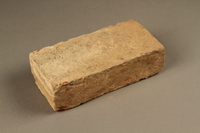Overview
- Brief Narrative
- Brick manufactured by the Kőszeg Varosi Teglagyàr (Kőszeg Urban Brickworks) in Kőszeg, Hungary. Jewish residency in the town began in the 14th century and continued for five hundred years. From 1919 to 1921, Jews in Kőszeg and throughout Hungary were targeted by the White Terror pogroms for their perceived association with communism. Leading up to World War II, the Jewish population in the town was approximately one hundred people. In December 1940, a forced labor camp was established with Jewish and non-Jewish workers at a brick field and an old brewery in the town. The camp housed eight thousand laborers who were forced to march ten kilometers to and from work. They worked ten hour days, seven days a week, with only a daily ration of 17 ounces of bread. In March 1944, Germany occupied Hungary and the Jews of Kőszeg along with other Jews from the surrounding area were confined to a small ghetto in the town. On July 4, they were deported to Auschwitz-Birkenau killing center in German occupied Poland. In March 1945, the Germans liquidated the labor camp. As part of the liquidation, ninety five sick laborers were locked in a sealed barrack and gassed to death on the property of the brick factory. In 1985, a park and a memorial were erected on the property of the former brick factory.
- Date
-
manufacture:
1850-1950
- Geography
-
manufacture:
Kőszeg (Hungary)
- Credit Line
- United States Holocaust Memorial Museum Collection, Gift of Dr. József Rábai
- Markings
- a. top, center, impressed, manufacturer’s mark : V 1 [VÁROSI TEGLAGYÁR]
- Contributor
-
Manufacturer:
Ko?szeg Urban Brickworks
Physical Details
- Language
- Hungarian
- Classification
-
Materials
- Category
-
Building materials
- Object Type
-
Bricks (lcsh)
- Genre/Form
- Bricks. Building materials.
- Physical Description
- a) Larger left side of a gray colored clay brick with a porous surface and rounded edges. The brick has broken diagonally through the center, revealing a red interior. The top center has half of the manufacture’s mark pressed into the surface. The front, back and bottom are speckled with pale white spots and the bottom is heavily pitted. The lower front edge has a large indentation.
b) Smaller right side of a gray colored clay brick with a porous surface and rounded edges. The brick has broken diagonally through the center, revealing a red interior. The top center has half of the manufacture’s mark pressed into the surface. The front, back and bottom are speckled with pale white spots and the bottom is heavily pitted. - Dimensions
- a: Height: 2.625 inches (6.668 cm) | Width: 7.325 inches (18.606 cm) | Depth: 4.750 inches (12.065 cm)
b: Height: 2.625 inches (6.668 cm) | Width: 5.750 inches (14.605 cm) | Depth: 4.625 inches (11.747 cm) - Materials
- overall : brick
Rights & Restrictions
- Conditions on Access
- No restrictions on access
- Conditions on Use
- No restrictions on use
Keywords & Subjects
- Topical Term
- Holocaust, Jewish (1939-1945)--Hungary. Kőszeg (Hungary)--History. Jews--Hungary--History. Manufacturing industries--Hungary.
- Geographic Name
- Kőszeg (Hungary) Kőszegfalva (Kőszeg, Hungary)
- Corporate Name
- Koszeg (Concentration camp)
Administrative Notes
- Legal Status
- Permanent Collection
- Provenance
- The brick was donated to the United States Holocaust Memorial Museum in 2017 by Dr. József Ràbai.
- Record last modified:
- 2024-02-21 07:11:14
- This page:
- https://collections.ushmm.org/search/catalog/irn592500
Download & Licensing
In-Person Research
- By Appointment
- Request 21 Days in Advance of Visit
- Plan a Research Visit
- Request to See This Object
Contact Us
Also in Hungarian brick collection
The collection consists of two bricks from local brick factories relating to events in the area of Kőszeg, Hungary, during the Holocaust.
Date: 1850-1950

Brick manufactured by the Czeke brick factory in Kőszeg
Object
Brick manufactured by the Czeke Brick Factory in Kőszeg, Hungary. Jewish residency in the town began in the 14th century and continued for five hundred years. From 1919 to 1921, Jews in Kőszeg and throughout Hungary were targeted by the White Terror pogroms for their perceived association with communism. Leading up to World War II, the Jewish population in the town was approximately one hundred people. In December 1940, a forced labor camp was established with Jewish and non-Jewish workers at a brick field and an old brewery in the town. The camp housed eight thousand laborers who were forced to march ten kilometers to and from work. They worked ten hour days, seven days a week, with only a daily ration of 17 ounces of bread. In March 1944, Germany occupied Hungary and the Jews of Kőszeg along with other Jews from the surrounding area were confined to a small ghetto in the town. On July 4, they were deported to Auschwitz-Birkenau killing center in German occupied Poland. In March 1945, the Germans liquidated the labor camp. As part of the liquidation, ninety five sick laborers were locked in a sealed barrack and gassed to death on the property of Kőszeg Varosi Teglagyàr (Kőszeg Urban Brickworks), another local brick factory. In 1985, a park and a memorial were erected on the property of the former brick factory where the execution took place.



